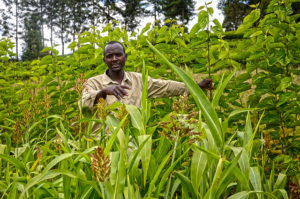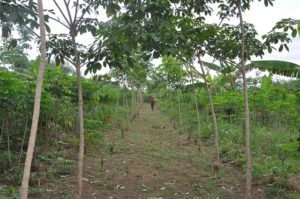
A recent article on research in Brazil yields seven flexible options for farmers who wish to use agroforestry as a means to comply with regulations while benefitting their land and livelihoods.
Setting aside conservation areas on Brazil’s farms and rural properties isn’t just good for the ecosystem, the climate and biodiversity – it’s the law. In 2012, the country passed a new Brazilian Forest Code known as the Law for Protecting the Native Vegetation.
This code expands on an older law that obliges all farmers and rural property owners to set aside a portion of their land, known as Permanent Preservation Areas and Legal Reserves, for conservation.
Mandating the restoration of a portion of a farmer’s land with a mix of native species carries potential negative short-term economic impacts despite the collective environmental services. Obligatory conservation and/or restoration using conventional methods consisting of planting native trees can reduce the immediate economic potential of the land, which could otherwise be used to farm commercial crops. But this is not necessarily the case.
For the many smallholders, or ‘family farmers’ in Brazil, incorporating agroforestry systems (AFS) is a legally acceptable land use which satisfies the definition of a conservation area. However, regulation is still fledgling and consistency in its application has been erratic.
So what is the best way to incorporate AFS into farm land and rural areas while maximizing species diversity, ecosystem benefits, and ultimately, livelihood benefits?

The answer is complex due to inconsistencies in regulation, and substantial differences among farmers’ means and goals, access to markets and biophysical conditions, crop choices, and scant access to knowledge on landowners’ restoration options. To help alleviate these knowledge and practical gaps and to strengthen enabling factors like policy and regulation, a body of research was conducted in the Cerrado and Caatinga biomes to analyze the best AFS options.
Through a literature review, interviews with stakeholders, a national workshop and a series of on-site farmer experiences and observations, the research team led by the World Agroforestry Centre (ICRAF) and partners, including FTA researchers, set out to determine if and how AFS was indeed a viable option for smallholders to both fulfill their legal obligations to conserve and/or restore land and maximize livelihoods and other benefits.
Read the full open source article on Cambridge University Press.
Based on the research, and accounting for biome or landscape context and farmer experiences, seven broad options were identified for farmers and rural landowners as flexible solutions that are adaptive enough to fit most circumstances and cater to individual needs and capabilities. While uptake of these techniques by farmers is a key component, an equally significant result is that state regulators and extension agents, armed with an understanding of these options, are better able to oversee implementation of the new Forest Code and therefore generate consistent services and policy.
The options are:
- high-input successional agroforestry systems for the Cerrado: planting in beds with annual crops and vegetables with rows of fertilizer trees and agroforestry species;
- planting alternate strips of agroforestry and native species;
- planting ‘fertilizer’ and ‘engineer’ species in rows or ‘islands’ (clusters) throughout the area;
- planting seeds and seedlings for enrichment and managing natural regeneration;
- agroforestry for restoring steep hillsides in terraces or swales in the Cerrado or soft slopes in the Caatinga;
- forage agroforestry systems in the Caatinga; and
- restoring degraded lands in the Caatinga beginning with “engineer” and “fertilizer” species.
This study concludes that AFS is a viable option for smallholder farmers to reconcile with the Forest Code’s goal of increasing conservation while improving the land, and reaping economic and environmental benefits. As notably stated in the article, [AFS] “can indeed provide practical solutions for turning the onus of restoration into a bonus for farmers.”
Originally published on the IUCN website.
This study is part of a partnership between IUCN and ICRAF funded by ‘Improving the way knowledge on forests is understood and used internationally (KNOWFOR)’ under a grant awarded to IUCN by UK Aid from the UK government. In Brazil, this project is coordinated by ICRAF in partnership with IUCN, Embrapa (Brazilian Agricultural Research Corporation), ISPN (Institute for Society Population and Nature), SFB (Brazilian Forest Service), ISSA (Instituto Salvia) and Mutirão Agroflorestal.
The research forms part of the CGIAR Research Program on Forests, Trees and Agroforestry (FTA), supported by CGIAR Fund Donors.











